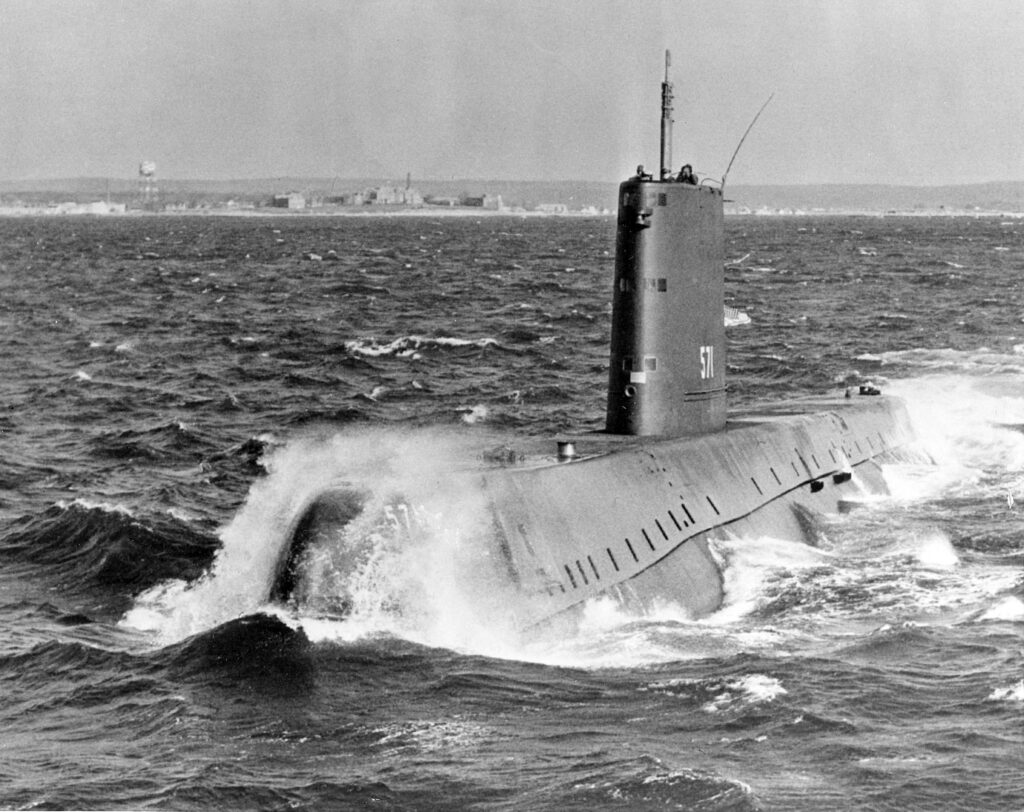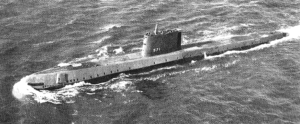 These days crowds gather near ocean shores to watch Space X launch rockets. On January 17, 1955, the crowds were on the banks of the Thames River in Connecticut watching Commander Eugene P. Wilkinson and the crew of USS Nautilus (SSN 571) depart for her first test voyage, powered by a technology unknown less than ten years earlier. At 11 am Eastern, we mark 70 years since CDR Wilkinson transmitted his historic message, “underway on nuclear power.”
These days crowds gather near ocean shores to watch Space X launch rockets. On January 17, 1955, the crowds were on the banks of the Thames River in Connecticut watching Commander Eugene P. Wilkinson and the crew of USS Nautilus (SSN 571) depart for her first test voyage, powered by a technology unknown less than ten years earlier. At 11 am Eastern, we mark 70 years since CDR Wilkinson transmitted his historic message, “underway on nuclear power.”
Today we should marvel at how they–led by Admiral H. G. Rickover–were able to go from approval to create a naval nuclear reactor to underway on nuclear power in less than six years and how the U.S. Naval Nuclear Power Program has sustained the competitive advantage Admiral Rickover built for them 70 years ago.
History
Accounts vary on when exactly the program to build Nautilus began, but all agree that the consensus was that any project would take at least a decade to deliver results. Yet, by the time of the keel laying in June 1952, President Truman was already calling the progress “miraculous.”
As early as 1948, then Captain Rickover thought the problem straightforward. In December 1948, Rickover, working in the Navy Bureau of Ships was quoted as saying, “Production of usable power from nuclear fission is essentially an engineering problem that can be solved by usual engineering means.” After Nautilus’ launch, Rickover again described the project as “90 per cent engineering and only 10 per cent physics.” The historical record shows that Rickover’s math may have been slightly off as he didn’t include any percentage of effort toward overcoming the hefty bureaucratic challenges which threatened any delivery, let alone an early delivery of Nautilus.
Ever since Rickover had arrived in June 1946 at Oak Ridge to learn about nuclear physics, he had a vision for how nuclear energy could transform submarine propulsion. Later congressional commendation would note that Rickover’s, “foresight and follow through more than that of any other person brough the successful creation of the Nautilus.” An article in Rickover’s hometown Chicago Daily Tribune on September 4, 1951, noted, “Capt. Rickover’s fight for the new type of submarine has been a long, and sometimes bitter one. Associates say he has persisted at times in spite of resistance from the higher brass in the navy.”
Rickover was known for his tireless energy and fierce drive for results. He was described as, “a fiery, hard driving taskmaster who is willing to work 16 hours or more a day on his project.” Delivering the nuclear-powered submarine was described as Rickover’s “burning obsession.”
In July 1952 then Secretary of the Navy, Dan Kimball, awarded Rickover the Legion of Merit. The citation read, in part:
“He has held tenaciously to a single important goal thru discouraging frustration and opposition and has consistently advanced the submarine thermo reactor well beyond expectations; his efforts have led to the laying of the keel of the world’s first nuclear powered ship well in advance of its original schedule….His careful and accurate planning, his technical knowledge and his ability to clarify and resolve problems arising between the atomic energy commission, the bureau of ships, and civilian contractors have proved a contribution of inestimable value to the country’s security and reflect great credit upon Capt. Rickover and the United States naval service.”
Weeks later Rickover would be passed over for promotion to rear admiral for a second time, prompting, by law, his forced retirement the following year at the age of 52. The press headline cried “Brazen Prejudice”, arguing general officers were opposed to technical specialists like Rickover. They called for someone to take special action; Congress responded to their call.
Representative Yates (D., Ill.) and Hinshaw (R., Cal.) and Senator Jackson (D., Wash.), amongst others, intervened. They sent letters to President Eisenhower. They held hearings. In January 1953, Secretary of the Navy Kimball refused to intervene. Of Rickover and the situation, Jackson noted:
Rickover is an intellectually honest scientist. He doesn’t want to be an admiral, really. He isn’t looking forward to the big money which General Electric or Westinghouse would be happy to pay him when he retires. What concerns him, and all of us, is that young navy men of scientific bent may be frightened away from scientific work when they see how lowly the work is regarded by the older brass.”
As the fighting for Rickover’s promotion continued in Congress, newspapers across the nation printed articles on Rickover, his accomplishments, and his methods for delivering results. The Columbia Missourian reported,
It is because of Rickover’s drive and energy that the new sub is being completed only five years after its beginning. He picked top nuclear physicists and engineers and set them to work, breaking red tape, finding short cuts, and getting manufacturers to speed up production of vital materials. He broke tradition by keeping his men from being transferred after three years’ duty on the atomic sub. He has gone over the heads of his superiors in certain matters to get things done faster. He is a strong individualist, something that cannot be tolerated in military circles…. Gordon Dean, chairman of the Atomic Energy Commission, said “I think I know every topflight atomic engineer in the country, and I don’t know one, Navy or civilian, who could do the job Rickover is doing.”
The News Tribune in Tacoma, Washington shared this:
The country’s atomic submarine project, which up to now has been doing exceptionally well, is imperiled by an intra-service row which will hit the headlines any day.
The controversy centers around the colorful figure of Capt. H. G. Rickover, head of the project. Known as a human dynamo, Captain Rickover, a Chicagoan, uses three secretaries, works 12 hours a day, including Saturday, and has been head of the atomic-submarine project since he himself began it back in 1945, soon after the atomic bomb was announced.
….
The pioneer of this revolutionary achievement has been the stormy petrel, Rickover. It is admitted even by his admirers that his personality is “rugged.” He is given to riding roughshod over anyone he thinks stands momentarily in the way of speeding the Nautilus, the world’s first true submarine, a ship which can operate independent of the surface of the ocean. But his defenders say that only his drive had kept the project going full speed ahead.
There is no other project leading to atomic power which has gone ahead as swiftly and successfully as the Navy program. The loss of Rickover would be very serious, not only for submarine power, but for the development of atomic energy in general.
Climbing on the pro-Rickover bandwagon, the Longview Daily News advocated strongly for Rickover and his results:
Rickover, a sparrow-faced, wiry man with graying hair, had not only the scientific ability to develop the atomic sub but he had what is more important to a man with new ideas at the Pentagon, the tenacity to fight the inch-by-inch battle with diehard battleship and carrier admirals to get money and approval for going ahead with his idea. The news reports from Groton, Conn., where the new sub was being built, were a tribute to Rickover’s triumph over naval indifference.
By March 1953, the new Secretary of the Navy, Robert Anderson took action, Anderson provided a two-fold solution. First, he would grant Rickover an extra year before any forced retirement and, second, he would declare one of the upcoming admiral positions must go to an officer with atomic experience, thus effectively earmarking a promotion for Rickover. Congress and the newspapers rejoiced at the positive news. Rickover was too busy to celebrate. On March 31, 1953, the Spokane Chronicle carried the news that the prototype reactor in Arco, Idaho had begun operations. Another step toward delivering USS Nautilus was complete. Representative Hinshaw of California extended his congratulations to Rickover, “who has driven this revolutionary project to completion over the protest and lethargy of the conventional military services and bureaucracy.”
Covering the energetic program for the Associated Press, Elton C. Fay reported in April 1953:
What is making the first atomic-powered craft in history?
You started out by knowing just one Navy captain, intent beyond all other interests on getting an atomic submarine built, Hyman G. Rickover. But you discovered, as you moved around from one place to another, that the project was full of Rickovers — hundreds and thousands of them.
He either had hammered his own zeal into them or it was contagious. Rickover spread the contagion. He kept popping up at near and far places, at unexpected times of the day and night, insisting on conferences.
In July 1953, the promotion board officially included Rickover’s name with those others promoted to rear admiral. Eisenhower and congress in turn approved the list. Rickover could now fully focus on simultaneously delivering Nautilus, and the follow-on nuclear submarine USS Seawolf, and the first commercial nuclear reactor project at Shippingport, Pennsylvania.
Mamie Eisenhower would christen Nautilus on January 21, 1954 and the project appeared on track for a launch date in October 1954. Piping problems and repairs delayed the launch until January 1955.
Covering the historic sailing of Nautilus in January 1955, the Binghamton Press in New York waxed poetic, “A new era, one limited only by the vision and imagination of men, opened this week with the launching of the world’s first atomic submarine, the USS Nautilus.” They continued, “Changes occur slowly and new eras are seldom greeted with fanfare. But something new was added this week with the launching of the USS Nautilus, something that in time will bring revolutionary changes in our perspectives and modes of life.”
Nautilus did radically change naval strategy and tactics. Where previous submarines could only achieve maximum underwater speed for one hour before surfacing, Nautilus was capable of submerging and moving at top speed indefinitely. Even with all that was achieved, in his only statement on Nautilus since its successful launch, Rickover in March 1955 said, “I’m never satisfied, because things aren’t moving fast enough. We’ve built the submarine, but now we’ve got a lot of things to do.”

Rickover, onboard Nautilus. He was on the submarine on January 17, 1955.
Learning
When we understand the challenges Admiral Rickover and all involved overcame, while delivering remarkable results at breathtaking speed, we should be encouraged. Today’s headlines of Space X catching rocket boosters with chop sticks grab our attention and the thought of conquering Mars stirs modern engineers, but we are not the first generation to be stirred by new frontiers and rise to the challenges. Others before us, especially Admiral Rickover and the early nuclear propulsion and nuclear power pioneers, knew how to deliver exceptional results quickly and sustainably. What they did, we too can do.
When Admiral Rickover is remembered these days, he is often remembered for his “rugged” personality, the gruff, demanding leader who never stopped. Yet, what we should also see is a man with a “vision” who was willing to put everything he had into it and rallied countless others to join him in his noble quest. Rickover didn’t ask anyone to do anything he wasn’t willing to do. He worked harder than everyone else. And, he understood how to build not just one reactor plant, but a whole system, industry, and philosophy which could outlive him and deliver continual, amazing results. What he did and how he did it is a learnable set of knowledge and skills. You don’t have to wish you could have been a part of his program or the Apollo program or any other historical program. You don’t have to long to work at Space X or the other few companies defying timelines and expectations today. You can bring Rickover’s thinking, tools, and tactics for delivering results into your work.
I started sharing his thinking, tools, and tactics in simple ways in my books, Everyone Is a Change Agent and Change Tactics. Now, as I re-launch Engine-for-Change, I intend to bring a broader and deeper set of learnings and practical tactics to share with those who choose to follow this blog, subscribe to my newsletter (coming soon), or partner with me as Engine-for-Change clients.
The world needs more sustainable results, and great organizations need lasting competitive advantage. By remembering the best of the historical change agents, like Admiral Rickover, and merging leading-edge, modern tactics, we can achieve our own memorable results.
Why not try?
Timeline
Jun 1946 – Rickover goes to Oak Ridge to learn about nuclear physics
Feb 1949 – Rickover assigned to lead the Atomic Energy Commission’s Division of Reactor Development
Aug 1951 – Electric Boat receives the contract to build USS Nautilus
Jun 14, 1952 – President Truman celebrates the laying of the keel of USS Nautilus
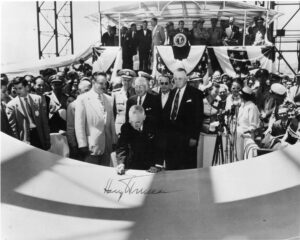
Mar 31, 1953 – The prototype nuclear reactor at Arco, Idaho goes into operation
Jan 21, 1954 – Mamie Eisenhower christens USS Nautilus

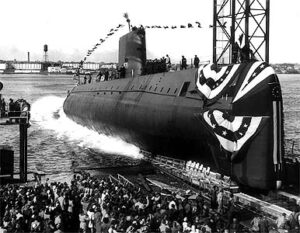
Jan 17, 1955 – USS Nautilus “underway on nuclear power”
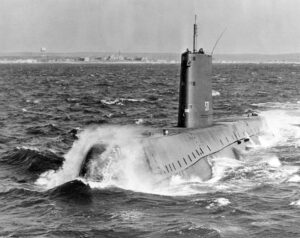
Mar 22, 1955 – USS Nautilus hosts members of the Congressional Atomic Energy Committee for an overnight cruise
Sources
The Olympian, Olympia, Washington; December 5, 1948 (accessed at Newspapers.com)
Chicago Daily Tribune, Chicago, Illinois; September 4, 1951 (accessed at Newspapers.com)
National Post, Toronto, Canada; October 27, 1951 (accessed at Newspapers.com)
Chicago Tribune, Chicago, Illinois; July 8, 1952 (accessed at Newspapers.com)
Kitsap Sun, Bremerton, Washington; August 5, 1952 (accessed at Newspapers.com)
Corpus Christi Caller-Times, Corpus Christi, Texas; January 16, 1953 (accessed at Newspapers.com)
York Daily Record, York, Pennsylvania; January 31, 1953 (accessed at Newspapers.com)
Omaha World Herald, Omaha, Nebraska; January 29, 1953 (accessed at Newspapers.com)
The News Tribune, Tacoma, Washington; February 4, 1953 (accessed at Newspapers.com)
Marysville Journal-Tribune, Marysville, Washington; February 23, 1953 (accessed at Newspapers.com)
Columbia Missourian, Columbia, Missouri; February 26, 1953 (accessed at Newspapers.com)
Longview Daily News, Longview, Washington; March 9, 1953 (accessed at Newspapers.com)
Spokane Chronicle, Spokane, Washington; March 31, 1953 (accessed at Newspapers.com)
The Daily Herald, Everett, Washington; April 6, 1953 (accessed at Newspapers.com)
Binghamton Press, Binghamton, New York; January 20, 1955 (accessed at Newspapers.com)
Lebanon Daily News, Lebanon, Pennsylvania; March 10, 1955 (accessed at Newspapers.com)
The Daily Times, Davenport, Iowa; March 23, 1955 (accessed at Newspapers.com)

